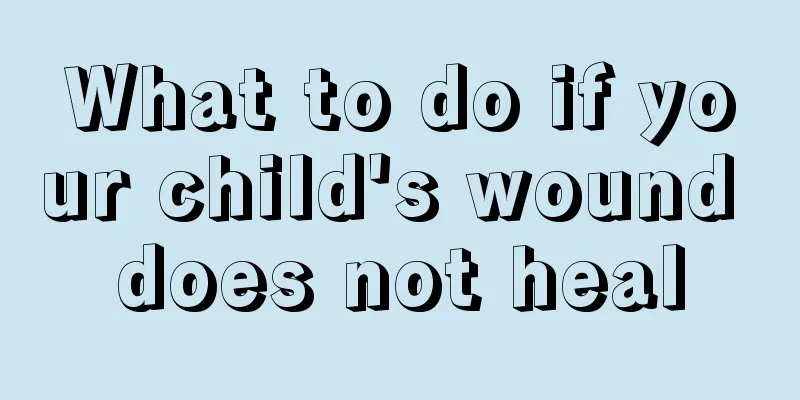What to do if your child's wound does not heal

|
In fact, it is a serious situation for children's wounds not to heal, which indicates that there is an abnormal problem inside the wound. When the skin is injured, it must be disinfected and bandaged, otherwise the internal tissues may be greatly affected. Severe patients may eventually face amputation or directly endanger the patient's life. Various injuries often cause damage to the skin and soft tissues, and even limb amputation in severe cases. If the wound is treated correctly, it can heal quickly; otherwise, it may become infected and fester, take a long time to heal, and even be life-threatening due to complications such as systemic infection, gas gangrene, tetanus, etc. Therefore, traumatic wounds must be treated strictly and seriously. Once the human body suffers trauma, if the wound is not treated in time, it is easy to cause infection. The principles of wound care are: 1. Stop bleeding: Stop bleeding in time according to the specific situation. 2. Bandaging: Proper bandaging of the wound can reduce bleeding, festering and pain. When tying the bandage, it should be done quickly, accurately, lightly and firmly. Fast means quick and agile movements; accurate means accurate and tight positioning; light means light movements without touching the wound; firmly means the bandage should be secure and of appropriate tightness. Procedure 1. Clean the wound: rinse the wound under running saline. Scrub the skin around the wound with a clean cloth and soap. Be careful not to get soap into the wound as it will sting your skin. Then use gauze or tweezers to clean the dirt in the wound. 2. Stop bleeding: Don’t think bleeding is a bad thing, it can help clean the wound. Smaller wounds will stop bleeding automatically soon. If you want to stop the bleeding quickly, it is best to use a clean cloth attached to a harder object to press on the wound. If the wound is on a limb, raise the injured part so that it is relatively higher than the heart and the bleeding will slowly stop. 3. If it is difficult to stop the bleeding, use a bandage: If the bleeding does not stop after applying pressure with a hard object for more than 10 minutes, you should use a bandage. Bandages can help wounds that haven't closed heal. If the wound is easily soiled or easily rubbed at any time, you can use medical bandages and adhesive tape to cover the wound. But remember to change the gauze every day and keep it dry and clean. If the wound is deep and the edges cannot be restored, it will need to be sutured to avoid infection. Dealing with blood scabs: The best way to deal with blood scabs is to do nothing. Scabbing on the wound can prevent contamination by dirt. Try your best to prevent your child from knocking off the blood scab. The blood scab will fall off automatically when the wound heals. |
<<: How to eliminate abdominal distension in children
>>: How to relieve children’s vomiting?
Recommend
Which kind of antipyretic patch is good for children
The pediatric fever-reducing patch is a new type ...
4 year old baby snoring
In fact, the symptom of snoring is very harmful t...
The baby suddenly has leg pain and can't walk
Many babies have leg pain in their lives, but aft...
What causes dark circles under girls' eyes?
Generally speaking, lesbians will not have dark c...
Introduction to daily diet for two-week-old babies
What should a two-week-old baby eat? What should ...
How to prevent baby’s enteritis after taking medicine?
Spring is here. If you don't pay attention to...
What medicine should children take for hand, foot and mouth disease
We all know that when summer comes, because of th...
How to guide your baby to squat and urinate
When the child can say some simple words, you can...
Three-year-old child peeling fingers
For some babies, parents are very concerned about...
What are the causes of urticaria in children?
Infants and young children are prone to urticaria...
What are the symptoms of heat stroke in children?
Heatstroke is a common thing in daily life for ma...
Can I swim after getting the vaccination?
Every baby will get vaccinations after birth to p...
Three methods of correcting baby's head shape
Because the bones of a baby's head are not fu...
What should I do if my child has astigmatism?
Astigmatism is a common eye disease, characterize...
Are children's fever patches effective?
Children have relatively poor immunity, so they a...









